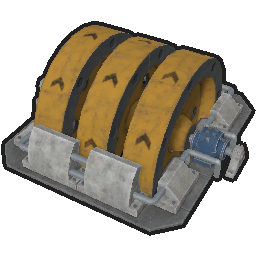Flywheel

| Construction | |
| Workers | None |
| Electricity | None |
| Maintenance | None |
| Footprint | 7x7 |
| Required Research | Mechanical Power Storage |
| Designation | Power Production |
The Flywheel is the machine that provides the sole means of storage of Mechanical Power. Its primary purpose is to provide smoothing of Electricity requirements and/or to provide the player additional reaction time in case of a brownout. While other methods of energy storage can be built, such as thermal energy storage systems in the form of Steam (High) or Steam (Low) in a Thermal Storage, the Flywheel is currently the only machine which stores energy losslessly and with instant access.
Physically it features a longitudinal shaft connected through several large weighted wheels. Energy is thus stored as momentum as a product of their rotational speed and mass.
When the Flywheel's shaft is connected to both a generator and a turbine, it will consume any excess Mechanical Power which is not being used to generate Electricity up until it is fully charged or excess power disappears. At full charge, it is capable of storing 500 MW-seconds (500 MW- ![]() ) worth of energy: more simply, 1 MW of output for 500
) worth of energy: more simply, 1 MW of output for 500 ![]() , 50 MW of output for 10
, 50 MW of output for 10 ![]() , or any other multiple thereof. When there is greater demand on the shaft for Electricity generation than is being provided by the generator, the Flywheel will donate its energy to provide the additional Mechanical Power needed.
, or any other multiple thereof. When there is greater demand on the shaft for Electricity generation than is being provided by the generator, the Flywheel will donate its energy to provide the additional Mechanical Power needed.
Flywheels only experience power loss when idle, defined as when there is no input or output of mechanical power on the shaft, or when the shaft's inertia is above 95%. Otherwise, adding flywheels does not negatively impact generator output. A system can viably incorporate 20 flywheels, provided there are always active generators or turbines on the same shaft, minimizing power loss. Turbines lose power during spin-up and spin-down phases. Adding more flywheels to the system increases efficiency by stabilizing the shaft, thus reducing the need for turbines to frequently turn on or off, especially in auto-balance mode. Losses related to flywheels are calculated per shaft, rather than per individual machine.
| |
| |
| Planned or Proposed | |
| * Only available in the Supporter Edition | |